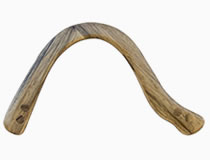The material of this article is for informational purposes and is based on data from the profile aerodynamics analysis program. The interpretation of the data is subjective and may not be accurate.
For testing the boomerang, in the field, temporary solutions can be used that change the characteristics of the wing without modifying the profile itself (without grinding the edges, etc.). For this, for example, thin plates of cardboard or any other material can be used, adding them to a particular place on the wing and attaching with adhesive tape (insulating tape, plaster, etc.).
Instead of cardboard, you can use, for example, a coin, which, among other things, adds weight and shifts the balance of the boomerang, thereby changing its characteristics.

Such a solution, in any case, increases drag, but changes in lift have a stronger effect, which makes it possible to assess how the flight of the boomerang will change if adjustments are made in one or another place of the wing.
Another option is the use of spoilers (interceptors), which can be made with the same tape by folding it in the following form:

These manipulations will have a stronger effect on the flight of the boomerang, provided that the boomerang wing does not have a deliberately set large angle of attack. I.e., the angle of attack is close to or equal to 0.
The terms used in the article are described here.
Basic profile
As a base, a profile with the name W030s is used. The rest of the profiles in this article are based on it.

Wing thickening
A variant with plates. W030s_top and W030s_bottom are modified profiles of the base W030s.

When adding a thickening on the upper plane of the wing (W030s_top), the simulation showed that the lifting force, if it became larger, was extremely insignificant. Shifting back and forth did not give results. The drag has become noticeably greater.

When adding a thickening to the lower plane of the wing (W030s_bottom), the changes are more obvious.

The lifting force is significantly reduced, so this technique is quite suitable for testing.
Spoilers
Profile W030s_flap, approximately simulates the gluing of a certain thickening on the upper plane of the trailing edge.

Spoilers, as well as thickenings, can be tried to make different heights and widths, and placed on different parts of the wing. This will allow you to see what effect a spoiler located in a particular place has.
Such a device disrupts the air flow, significantly reducing the efficiency of the wing at the place of its installation. The graph confirms this.

Holes
Drilled holes in the boomerang wings are used to reduce the efficiency of the wing, stabilize and change the flight characteristics. This makes it possible, if necessary, to simply seal the hole with tape, restoring the original condition.



